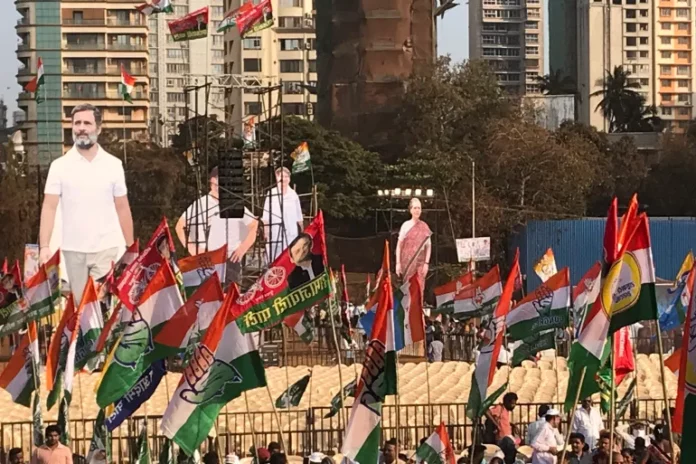Opposition Rally at Shivaji Park: Chants for Justice
Location: Mumbai, India
Introduction: Thousands of people gathered at Shivaji Park, Mumbai, a historic site of freedom movements, echoing chants for justice. This time, the target was Prime Minister Narendra Modi’s Bharatiya Janata Party (BJP).
Atmosphere at the Rally:
- The event featured Bollywood singers, flags, and life-sized cutouts of opposition politicians.
- Despite heavy police presence, the atmosphere resembled a festive concert.
- Rahul Gandhi, scion of the Nehru-Gandhi family, spearheaded the event.
Launch of Election Campaign:
- The Indian National Developmental Inclusive Alliance (INDIA) launched its election campaign, challenging the BJP.
- Nearly a billion Indians will vote in a seven-phase election from April 19 to June 4.
Opposition’s Strategy:
- The INDIA alliance aims to counter BJP’s dominance, accusing it of religious polarization and favoritism.
- Gandhi’s nationwide marches, like the Bharat Jodo Nyay Yatra, seek to galvanize support against Modi.
Public Response:
- Supporters like Ganggu Bai, a Mumbai resident, expressed hope in the opposition’s message of unity and justice.
Political Message:
- Gandhi emphasized the fight for a vision of India, alleging BJP’s control over institutions like EVMs and law enforcement agencies.
Key Figures and Statements:
- Leaders from the INDIA alliance, including Mallikarjun Kharge and MK Stalin, rallied against BJP’s policies.
- Uddhav Thackeray vowed to exile BJP, emphasizing unity within the opposition.
Evaluation of Gandhi’s Marches:
- Gandhi’s Bharat Jodo Nyay Yatra aimed at addressing issues of poverty, unemployment, and communal polarization.
- While hailed by some as a massive outreach effort, critics doubt its electoral impact, citing BJP’s narrative dominance.
Criticism and Challenges:
- Critiques highlight Congress’ organizational weaknesses, nepotism, and BJP’s propaganda against Gandhi.
- Sam Pitroda defends Congress’ democratic nature but acknowledges challenges in competing with BJP’s structured approach.
Unity and Renewed Vigor:
- Despite challenges, the marches have united Congress members and workers, revitalizing the party’s grassroots efforts.
The opposition rally signifies a renewed effort to challenge BJP’s dominance, with Gandhi’s marches playing a pivotal role in mobilizing support and revitalizing the Congress party.
What’s next?
The INDIA alliance has faced internal divisions as key leaders departed due to political disagreements. However, Mahadev emphasized that the yatras have played a crucial role in shaping the opposition’s manifesto.
“In our initial yatra phases, as we traversed different states, engaging with a wide array of stakeholders, their voices and concerns significantly influenced our manifesto,” she explained. “Our manifesto is a culmination of inputs not only from our allies within the INDIA bloc but also from various regional parties.”
Mahadev conceded that the direct impact of these marches on electoral outcomes remains uncertain. Nevertheless, she clarified that garnering votes was not the sole purpose of the yatras.
“While converting footprints into votes is not guaranteed, the essence of the yatras was to connect with people from diverse backgrounds, including marginalized communities,” she elaborated. “These engagements weren’t political rallies but opportunities for genuine dialogue, enabling us to comprehend and amplify the voices of the people.”
She emphasized that for Gandhi, these marches symbolized a quest for “peace and unity,” and a commitment to “defend India’s democratic values.”
